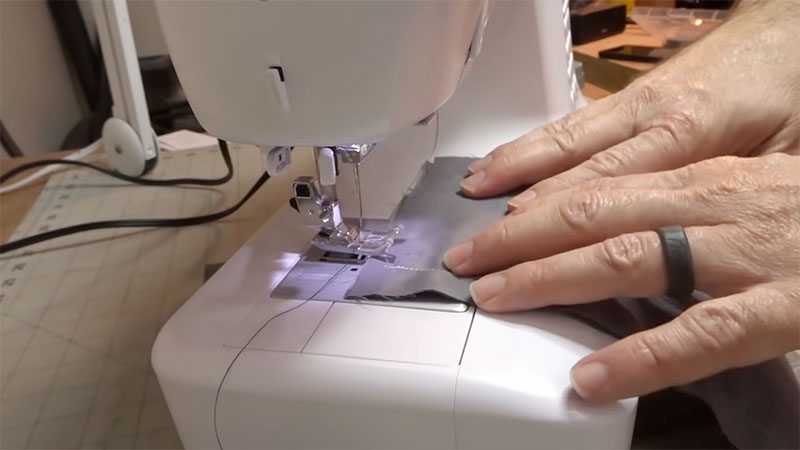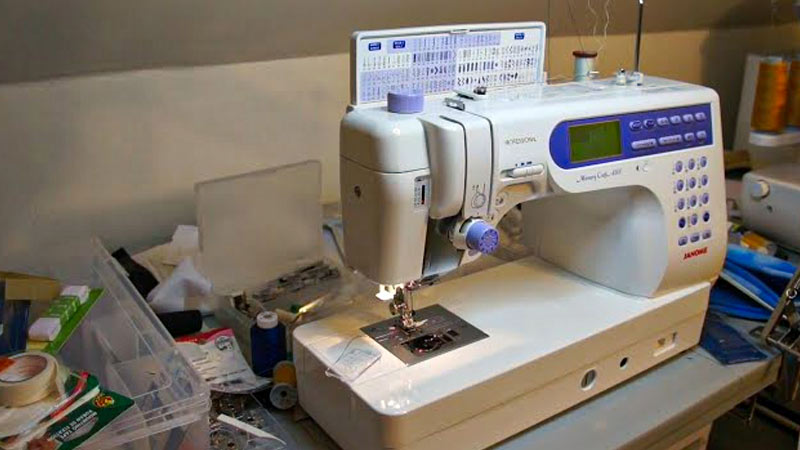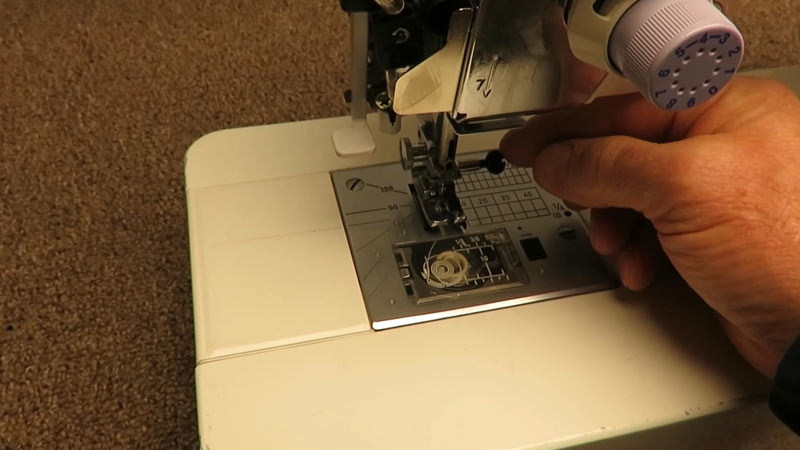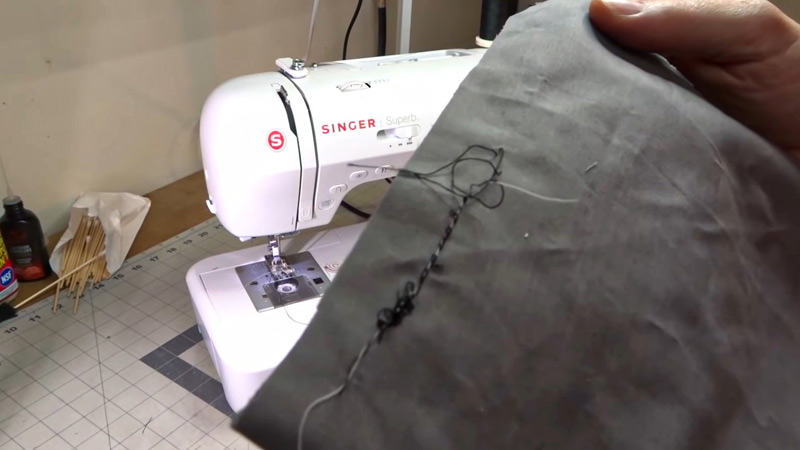The Janome 6500 sewing machine is a remarkable tool for creating beautiful garments and crafts, but like any precision instrument, it occasionally encounters operational hiccups.
One of the most vexing issues that sewists encounter is the appearance of loops in their stitching. These loops, also known as thread loops or bobbin thread loops, can mar the quality of your sewing projects and lead to frustration.
Understanding the root causes behind these loops is crucial for anyone seeking to master their Janome 6500.
In this exploration, we will delve into the diverse factors that can contribute to the formation of loops on this sewing machine and offer insights into how to diagnose and rectify these issues, ensuring that your sewing endeavors proceed smoothly and your creations are flawless.

What Causes Loops on a Janome 6500 Sewing Machine?
Loops on a Janome 6500 sewing machine, or any sewing machine for that matter, can be quite frustrating and can result in imperfect stitching.
These loops are typically referred to as “thread loops” or “bobbin thread loops.” Understanding what causes these loops is essential to troubleshoot and resolve the issue effectively.
Here are some common causes of loops on a Janome 6500 sewing machine:
Incorrect Threading
One of the most common causes of loops is incorrect threading. Ensure that you have threaded the machine correctly according to the manufacturer’s instructions. Pay close attention to threading the upper thread through all the thread guides and tension discs. Similarly, make sure the bobbin is correctly inserted and wound.
Tension Issues
Incorrect Janome tension settings can lead to loops. The Janome 6500 has both upper and lower tension settings.
If the upper tension is too tight or too loose, it can cause loops and threads in sewing machine.
Adjust the upper tension knob as needed to achieve the proper tension for your fabric and thread. Also, ensure the bobbin tension is properly adjusted.
Thread Quality
Using low-quality or old thread can result in loops. Ensure you are using good-quality thread that is suitable for your fabric. Old, brittle, or tangled thread can break or cause irregular tension.
Bobbin Issues
If the bobbin is not inserted correctly or if the bobbin case is damaged, it can lead to loops. Make sure the bobbin is seated properly in the bobbin case, and the bobbin case is correctly installed in the machine.
Needle Issues
A damaged or bent needle can cause loops. Make sure you are using the correct type and size of needle for your fabric. Change the needle regularly, especially if you are sewing through heavy or thick materials.
Fabric and Thread Mismatch
Using the wrong type of thread for your fabric or using a thread that is too thick for the needle size can result in loops. Ensure that your thread and fabric are compatible.
Sewing Speed
Sewing too quickly or forcefully can cause loops. Try sewing at a moderate and consistent speed, especially when sewing through multiple layers of fabric.
Machine Maintenance
Lack of proper maintenance can also lead to loops. Keep your Janome 6500 clean, well-oiled, and regularly serviced to ensure smooth operation.
Bobbin Tension Spring
If the bobbin tension spring is damaged or worn out, it can cause issues. Inspect the bobbin tension spring for any signs of wear or damage and replace it if necessary.
Thread Jam
A thread jam, where the thread gets stuck in the machine, can lead to loops. If you experience a jam, stop sewing immediately, and carefully remove the jammed thread before resuming.
Janome 6500 Problems

The Janome 6500 is a popular sewing machine known for its versatility and features. However, like any piece of equipment, it may encounter issues from time to time.
Here are some common Janome 6500 problems and potential solutions:
Thread Breakage
Frequent thread breakage can be caused by several factors, such as using old or low-quality thread, a damaged or bent needle, incorrect threading, or improper tension settings.
Ensure you are using quality thread, the correct needle, and follow proper threading and tension adjustment procedures.
Skipped Stitches
Skipped stitches can occur if the needle is dull, bent, or incorrectly inserted. Replace the needle regularly and ensure it’s properly positioned. Skipped stitches can also result from using the wrong type of needle for your fabric.
Uneven Stitching or Tension Issues
Uneven stitching or tension problems can be due to incorrect tension settings. Adjust the upper and bobbin tension as needed for your fabric and thread. Ensure the tension discs are clean and free from debris.
Thread Jam or Tangling
If your machine jams or the thread gets tangled, it may be caused by improper threading, a foreign object in the bobbin area, or incorrect bobbin winding. Re-thread the machine, remove any obstructions, and wind the bobbin correctly.
Loud or Unusual Noises
Unusual noises may indicate a problem with the machine’s internal components. Turn off the machine and check for loose parts or debris in the bobbin area. If the issue persists, it may require professional servicing.
Feed Dog Issues
If the feed dogs (the teeth that move the fabric) don’t engage or move unevenly, your stitches may be irregular.
Check for any obstructions around the feed dogs and ensure they are correctly adjusted for your fabric.
Bobbin Tension Problems
When you notice bobbin thread loops on the top of your fabric, it could be a bobbin tension issue. Adjust the bobbin tension screw slightly to achieve balanced tension.
Needle Positioning
Ensure that the needle is centered and properly aligned. Misaligned needles can lead to stitching problems.
Machine Jam or Locking Up
When your machine locks up and won’t move, it could be due to a mechanical issue. Turn off the machine, unplug it, and carefully check for any obstructions or thread tangles. If the problem persists, seek professional repair.
Threader Malfunction
When the automatic needle threader stops working, it may need cleaning or adjustment. Consult your machine’s manual for specific instructions on cleaning and troubleshooting the threader.
My Janome Sewing Machine Keeps Jamming -Causes & Fixes

Experiencing frequent jams with your Janome sewing machine can be frustrating, but there are several common reasons why jams occur and steps you can take to resolve the issue.
Here’s a troubleshooting guide to help you address jamming problems:
Check the Needle
A bent or dull needle is a common cause of sewing machine jams. Make sure you’re using the correct needle type and size for your fabric, and replace the needle if it’s damaged or has been in use for an extended period.
Thread Tension
Incorrect thread tension can lead to jams. Ensure that both the upper and lower thread tensions are properly adjusted according to your machine’s manual. Typically, a balanced tension results in even stitching.
Thread Quality
Poor-quality or old thread can lead to thread breakage and jams. Use high-quality thread that matches your fabric, and ensure it’s not old or brittle.
Proper Threading
Verify that the machine is threaded correctly. Incorrect threading can easily cause jams. Follow the threading diagram in your manual and ensure the thread is properly seated in the tension discs and guides.
Bobbin Issues
Ensure the bobbin is correctly wound and inserted into the bobbin case. A poorly wound bobbin or improper placement can lead to jams.
Clean the Machine
Accumulated lint, dust, and thread fragments in the bobbin area and feed dogs can lead to jams. Regularly clean your machine, particularly the bobbin area, with a brush or compressed air.
Fabric and Needle Compatibility
Make sure you’re using the appropriate needle and thread for the type of fabric you’re sewing. Heavy fabrics may require a larger needle, while lightweight fabrics need a finer one.
Machine Speed
Sewing too quickly or forcefully can increase the chances of jams, especially when working with challenging fabrics or thick layers. Slow down your sewing speed, especially in tricky areas.
Bobbin Tension
Check the bobbin tension. If the bobbin tension is too tight or too loose, it can cause jams. Consult your machine’s manual for instructions on adjusting bobbin tension.
Needle Position
Ensure the needle is properly centered and not hitting the presser foot or throat plate. Misaligned needles can cause jams.
Feed Dog Height
If the feed dogs are not at the correct height, they may not grip the fabric properly, leading to jams. Consult your manual for instructions on adjusting the feed dog height.
Thread Thickness
Extremely thick or thin threads may cause issues. Adjust your thread choice to match your fabric and needle size.
Maintenance
Regularly service your sewing machine to keep it in optimal condition. If you’ve tried all the above steps and continue to experience jams, it may be time for a professional service or inspection.
Sewing Machine Stitches Looping Underneath

When your sewing machine stitches are looping underneath the fabric, it’s often a frustrating issue that can affect the quality of your sewing projects.
This problem is typically characterized by loose or messy loops of the bobbin thread appearing on the underside of the fabric.
Several factors could be causing this issue, and here are some common causes and solutions:
Incorrect Bobbin Tension
Solution: Adjust the bobbin tension. Slightly increase the tension by turning the bobbin tension screw clockwise. Test on scrap fabric until you achieve balanced tension.
Imbalanced Upper Thread Tension
Solution: Check and adjust the upper thread tension. Make sure the upper thread is threaded correctly through all the guides and tension discs. Fine-tune the tension until it’s balanced for your fabric.
Uneven Bobbin Winding
Solution: Wind the bobbin evenly and with consistent tension. Ensure that the thread is wound smoothly on the bobbin, without any loose spots.
Thread Quality Issues
Solution: Use high-quality thread that matches the fabric you’re sewing. Avoid using old, brittle, or mismatched thread.
Needle Problems (Dull or Damaged)
Solution: Replace the needle with a new one, ensuring it’s the correct type and size for your fabric. A sharp, properly inserted needle is essential for clean stitching.
Incorrect Threading or Thread Path
Solution: Carefully rethread the upper thread, ensuring it follows the correct path through the machine, including all the thread guides and tension discs. Even a slight deviation can cause looping.
Lint and Debris Buildup
Solution: Regularly clean and oil your sewing machine following the manufacturer’s guidelines. Lint and debris can obstruct the thread path and affect stitching quality.
Bobbin Case Issues
Solution: Inspect the bobbin case for any damage or wear. If necessary, replace the bobbin case. Ensure the bobbin is inserted correctly into the bobbin case.
Thread Type and Fabric Mismatch
Solution: Ensure that the thread you’re using is compatible with the fabric you’re sewing. Heavy threads on lightweight fabrics or vice versa can cause looping.
Machine Problems
Solution: If looping continues after trying all the above solutions, it may indicate a more complex issue with the machine itself. In such cases, consider seeking assistance from a professional sewing machine technician for diagnosis and repair.
FAQS
Why does my Janome 6500 sewing machine make a clunking noise when it’s creating loops on the underside of the fabric?
The clunking noise could be due to a timing issue in your machine. Consult your user manual or contact a professional technician to inspect and adjust the machine’s timing.
What can I do if the loops on my Janome 6500 occur only when I sew over thick seams or multiple layers of fabric?
Loops when sewing over thick seams can be caused by insufficient presser foot pressure. Try increasing the presser foot pressure for better fabric control when sewing over bulky layers.
I’ve checked my needle, tension, and threading, but my Janome 6500 still produces loops. Could it be a bobbin case issue?
Yes, a damaged or worn bobbin case can cause looping. Inspect your bobbin case for signs of wear or damage and replace it if necessary.
Why do I get loops only when I sew in reverse on my Janome 6500?
Loops in reverse stitching can occur due to improper thread tension adjustment. Ensure that your upper thread and bobbin tension are correctly balanced for reverse stitching.
My Janome 6500 is new, and I’m still experiencing loops. Is this a common issue with this model?
While the Janome 6500 is a reliable machine, loop issues can occur even with new machines due to various factors.
Last Words
The appearance of loops on a Janome 6500 sewing machine can be attributed to a variety of factors, ranging from simple threading errors to more complex issues like tension problems or machine maintenance.
Identifying the root cause behind these loops is essential for maintaining the quality of your sewing projects.
By paying close attention to proper threading techniques, adjusting tension settings as needed, using high-quality materials, and ensuring the overall health of your machine, you can minimize the occurrence of loops and enjoy a smoother and more satisfying sewing experience.
Remember, troubleshooting and addressing these issues promptly will not only result in better stitch quality but also extend the lifespan of your Janome 6500, making it a reliable partner in your creative endeavors for years to come.
Leave a Reply